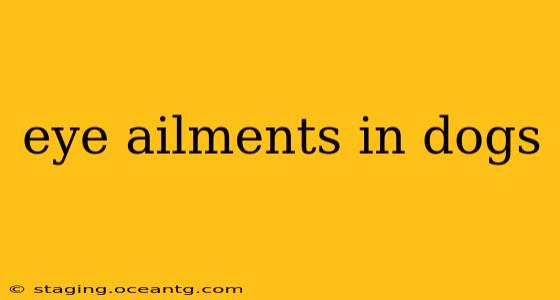As a devoted dog owner, noticing any changes in your furry friend's eyes can be alarming. Understanding common canine eye ailments is crucial for early detection and prompt veterinary care. This comprehensive guide explores various eye problems in dogs, offering insights into their causes, symptoms, and treatment options. Early intervention can often prevent more serious complications and preserve your dog's vision.
What are the Most Common Eye Problems in Dogs?
Many eye conditions affect dogs, ranging from minor irritations to severe, vision-threatening diseases. Some of the most prevalent include:
-
Conjunctivitis (Pink Eye): This inflammation of the conjunctiva (the membrane lining the eyelid and covering the white part of the eye) is often caused by allergies, infections (bacterial, viral, or fungal), or irritants. Symptoms include redness, swelling, discharge (clear, watery, or yellow-green), and squinting.
-
Dry Eye (Keratoconjunctivitis Sicca): Insufficient tear production leads to dryness and irritation of the cornea and conjunctiva. This can cause discomfort, redness, and cloudiness of the cornea, potentially leading to corneal ulcers.
-
Corneal Ulcers: These are sores on the cornea, often caused by trauma (scratches, foreign bodies), dry eye, or infections. Symptoms include squinting, excessive tearing, eye pain, and a cloudy or opaque cornea. Corneal ulcers require prompt veterinary attention to prevent serious complications.
-
Cataracts: These are opacities in the eye's lens, obstructing the passage of light and causing blurred vision. Cataracts can be congenital (present at birth) or develop with age. Symptoms include cloudy or bluish-white appearance of the lens, reduced vision, and difficulty navigating familiar environments.
-
Glaucoma: This condition involves increased pressure within the eye, damaging the optic nerve and leading to vision loss. Symptoms include dilated pupils, eye pain, redness, and squinting. Glaucoma is a serious condition that requires immediate veterinary care.
-
Progressive Retinal Atrophy (PRA): This inherited disease causes the degeneration of the retina, leading to gradual vision loss and eventual blindness. Symptoms vary depending on the specific type of PRA, but often include night blindness, reduced vision in low light, and eventual complete blindness.
-
Cherry Eye: This is a protrusion of the gland located within the third eyelid (nictitating membrane). It appears as a reddish mass in the inner corner of the eye. While often not painful, it can lead to irritation and infection if left untreated.
What Causes Eye Problems in Dogs?
The causes of canine eye ailments are diverse and can include:
- Genetics: Certain breeds are predisposed to specific eye conditions (e.g., PRA in certain breeds).
- Infections: Bacteria, viruses, and fungi can all cause eye infections.
- Trauma: Scratches, foreign bodies, and blows to the eye can lead to corneal ulcers and other injuries.
- Allergies: Environmental allergens can trigger conjunctivitis and other inflammatory conditions.
- Age: Senior dogs are more susceptible to conditions like cataracts and glaucoma.
- Underlying medical conditions: Certain systemic diseases can affect the eyes.
How are Eye Problems in Dogs Diagnosed?
Your veterinarian will perform a thorough eye examination, including:
- Visual acuity tests: Assessing your dog's vision.
- Slit-lamp examination: A magnified view of the eye's structures.
- Tonometry: Measuring intraocular pressure (for glaucoma).
- Fluorescein staining: Identifying corneal ulcers.
- Blood tests: Detecting underlying medical conditions.
How are Eye Problems in Dogs Treated?
Treatment depends on the specific condition and may include:
- Eye drops or ointments: For infections, dry eye, and inflammation.
- Oral medications: Antibiotics, anti-inflammatory drugs.
- Surgery: For cataracts, glaucoma, and cherry eye.
- Supportive care: Protecting the eye from further injury.
What are the Signs of Eye Problems in Dogs?
Recognizing early signs is crucial. Look for:
- Excessive tearing or discharge: Changes in the color, amount, or consistency of tear production.
- Redness or swelling: Inflammation of the eye or surrounding tissues.
- Squinting or pawing at the eye: Signs of discomfort or pain.
- Cloudiness of the cornea: Indicative of ulcers or cataracts.
- Pupil abnormalities: Dilated or constricted pupils.
- Changes in behavior: Lethargy, avoidance of light, difficulty navigating.
Can I Prevent Eye Problems in My Dog?
While not all eye conditions are preventable, regular veterinary checkups, including eye exams, can help detect problems early. A healthy diet, regular grooming (to remove debris), and avoiding potential eye injuries can also contribute to maintaining good eye health.
When Should I Take My Dog to the Vet?
Any noticeable changes in your dog's eyes warrant a veterinary visit. Don't delay seeking professional help, especially if you observe signs of pain, severe inflammation, or vision impairment. Early intervention is key to preserving your dog's vision and overall well-being.
This information is for general knowledge and does not substitute professional veterinary advice. Always consult with your veterinarian for diagnosis and treatment of your dog's eye problems.
